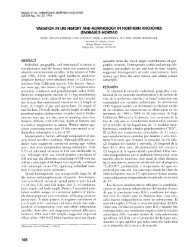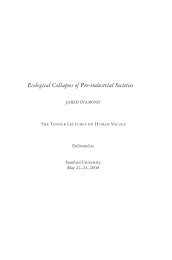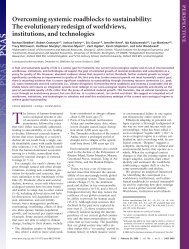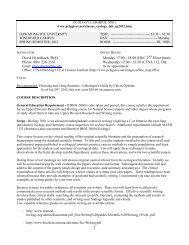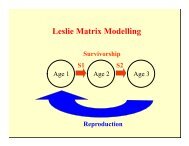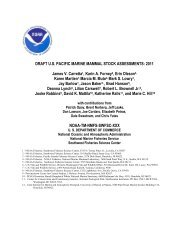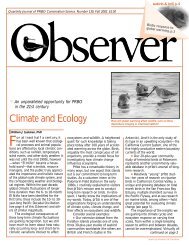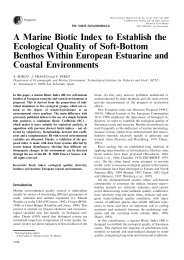A Unique Advantage for Giant Eyes in Giant Squid - Duke Biology ...
A Unique Advantage for Giant Eyes in Giant Squid - Duke Biology ...
A Unique Advantage for Giant Eyes in Giant Squid - Duke Biology ...
Create successful ePaper yourself
Turn your PDF publications into a flip-book with our unique Google optimized e-Paper software.
Please cite this article <strong>in</strong> press as: Nilsson et al., A <strong>Unique</strong> <strong>Advantage</strong> <strong>for</strong> <strong>Giant</strong> <strong>Eyes</strong> <strong>in</strong> <strong>Giant</strong> <strong>Squid</strong>, Current <strong>Biology</strong> (2012),doi:10.1016/j.cub.2012.02.031Why <strong>Giant</strong> <strong>Squid</strong> Have <strong>Giant</strong> <strong>Eyes</strong>5clicks of toothed whales [32, 33], leav<strong>in</strong>g vision their only option<strong>for</strong> detect<strong>in</strong>g distant approach<strong>in</strong>g predators. Despite theirhuge eyes, giant and colossal squid are thus unlikely to spota sperm whale be<strong>for</strong>e be<strong>in</strong>g revealed by the whale’s sonar.This argument implies that the ma<strong>in</strong> advantage of giant eyesis not to be able to move out of the whale’s detection rangebut rather to provide enough time to prepare <strong>for</strong> an effectiveevasive response. The large body required to build, susta<strong>in</strong>,and propel a pair of soccer-ball-sized eyes may also offerenough physical power to benefit from the early visual warn<strong>in</strong>gand allow <strong>for</strong> a suitably timed and <strong>for</strong>ceful escape behavior. It isthus possible that predation by large toothed whales hasgenerated a comb<strong>in</strong>ed selection driv<strong>in</strong>g the evolution of gigantism<strong>in</strong> both bodies and eyes of these squid.A group of ext<strong>in</strong>ct mar<strong>in</strong>e reptiles, the ichthyosaurs, are theonly other animals known to have had eyes that were similar <strong>in</strong>size to those of giant squid [34]. Contrary to previous belief[34, 35], our arguments suggest that also <strong>in</strong> ichthyosaurs thegiant eyes were adaptations <strong>for</strong> low-resolution tasks <strong>in</strong> dimlight. But ichthyosaur ecology clearly must have differedfrom that of giant squid. Ichthyosaurs were not built <strong>for</strong>ambush predation but had bodies suggest<strong>in</strong>g that they werecapable of susta<strong>in</strong>ed high-speed cruis<strong>in</strong>g, much like presentdayswordfish. Un<strong>for</strong>tunately, the fossils do not <strong>in</strong>dicatewhether they were day or night active, but they are thoughtto have dived to mesopelagic depths [34]. A general conclusionfrom our model<strong>in</strong>g is that the large ichthyosaur eyes(34–35 cm <strong>in</strong> diameter), just like giant squid eyes, had a significantselective advantage only <strong>for</strong> detection of large extendedtargets <strong>in</strong> dim light. For other visual tasks, much smaller (andless energetically expensive) eyes per<strong>for</strong>m almost as well.Ichthyosaurs lived <strong>in</strong> the mid-Triassic to mid-Cretaceous,long be<strong>for</strong>e the first whales evolved, and would presumablyhave used their large eyes <strong>for</strong> spott<strong>in</strong>g other large objects.Interest<strong>in</strong>gly, giant pliosaurs lived <strong>in</strong> the sea dur<strong>in</strong>g much thesame period as ichthyosaurs, and genera such as Kronosaurusand Rhomaleosaurus were massive apex predators [36]that may have posed a threat to ichthyosaurs. Some of thelarge-eyed ichthyosaurs were massive animals themselves,such as Temnodontosaurus [37], suggest<strong>in</strong>g the possibilitythat see<strong>in</strong>g each other <strong>in</strong> dim light was of crucial importance.Our model<strong>in</strong>g (Figure 3D) offers the least support <strong>for</strong> the developmentof huge eyes <strong>for</strong> spott<strong>in</strong>g prey. This argument is supportedby the laterally po<strong>in</strong>t<strong>in</strong>g eyes [34] and the lack of anaphakic gap <strong>for</strong> improved <strong>for</strong>ward vision <strong>in</strong> Temnodontosaurus,as judged from the circular sclerotic r<strong>in</strong>gs [37]. It seemsmore likely that the visual targets of ma<strong>in</strong> <strong>in</strong>terest to these giantichthyosaurs could appear <strong>in</strong> any direction.The computational approach to vision that we <strong>in</strong>troduce <strong>in</strong>this paper is useful not only <strong>for</strong> reveal<strong>in</strong>g possible reasons<strong>for</strong> exceptionally large eyes <strong>in</strong> squid and ichthyosaurs butalso <strong>for</strong> <strong>in</strong>vestigat<strong>in</strong>g numerous other aspects of visualecology <strong>in</strong> aquatic habitats. For depths that are largely <strong>in</strong>accessibleto humans, model<strong>in</strong>g of visual per<strong>for</strong>mance offersa unique way to <strong>in</strong>vestigate how animals can <strong>in</strong>teract visuallyand specialize their visual system to different detection strategies.The theoretical framework developed here can be adaptedto approach questions of visual ecology <strong>in</strong> any aquatichabitat from the bathypelagic to freshwater ponds.Supplemental In<strong>for</strong>mationSupplemental In<strong>for</strong>mation <strong>in</strong>cludes Supplemental Theory and can be foundwith this article onl<strong>in</strong>e at doi:10.1016/j.cub.2012.02.031.AcknowledgmentsWe are grateful to David Itano <strong>for</strong> allow<strong>in</strong>g us to copy the photo taken byErnie Choy <strong>in</strong> Figure 1 and to Carol Diebel and the staff at the Te PapaMuseum <strong>in</strong> Well<strong>in</strong>gton, New Zealand, <strong>for</strong> allow<strong>in</strong>g us access to an adultcolossal squid when it was thawed up <strong>in</strong> April 2008. We are also gratefulto Tsunemi Kubodera <strong>for</strong> provid<strong>in</strong>g <strong>for</strong>mal<strong>in</strong>-fixed material of an eye ofArchiteuthis dux. D.-E.N. and E.J.W. acknowledge fund<strong>in</strong>g from theSwedish Research Council.Received: December 18, 2011Revised: January 31, 2012Accepted: February 17, 2012Published onl<strong>in</strong>e: March 15, 2012References1. Land, M.F., and Nilsson, D.-E. (2002). Animal <strong>Eyes</strong> (Ox<strong>for</strong>d, New York:Ox<strong>for</strong>d University Press).2. Walls, G.L. (1942). The Vertebrate Eye and Its Adaptive Radiation(Bloomfield Hills: Cranbrook).3. Møhl, B., Wahlberg, M., Madsen, P.T., Heer<strong>for</strong>dt, A., and Lund, A. (2003).The monopulsed nature of sperm whale clicks. J. Acoust. Soc. Am. 114,1143–1154.4. André, M., Johansson, T., Delory, E., and van der Schaar, M. (2007).Forag<strong>in</strong>g on squid: the sperm whale mid-range sonar. J. Mar. Biol.Assoc. U. K. 87, 59–67.5. Beedholm, K., and Møhl, B. (2006). Directionality of sperm whale sonarclicks and its relation to piston radiation theory. J. Acoust. Soc. Am. 119,EL14–EL19.6. Howland, H.C., Merola, S., and Basarab, J.R. (2004). The allometry andscal<strong>in</strong>g of the size of vertebrate eyes. Vision Res. 44, 2043–2065.7. Fritsches, K.A., Brill, R.W., and Warrant, E.J. (2005). Warm eyes providesuperior vision <strong>in</strong> swordfishes. Curr. Biol. 15, 55–58.8. Roper, C.F.E., and Boss, K.J. (1982). The giant squid. Sci. Am. 246,96–105.9. Akimushk<strong>in</strong>, I.I. (1963). Cephalopods of the Seas of the USSR(<strong>in</strong> Russian). Izdatel/stvo Akademii Nauk SSSR. Moscow (Jerusalem,1965: Israel Program <strong>for</strong> Scientific Translation).10. Ellis, R. (1998). The Search <strong>for</strong> the <strong>Giant</strong> <strong>Squid</strong> (New York: The LyonsPress).11. Kubodera, T., and Mori, K. (2005). First-ever observations of a live giantsquid <strong>in</strong> the wild. Proc. Biol. Sci. 272, 2583–2586.12. Laughl<strong>in</strong>, S.B., de Ruyter van Steven<strong>in</strong>ck, R.R., and Anderson, J.C.(1998). The metabolic cost of neural <strong>in</strong><strong>for</strong>mation. Nat. Neurosci. 1,36–41.13. Herr<strong>in</strong>g, P.J. (2002). The <strong>Biology</strong> of the Deep Ocean (Ox<strong>for</strong>d, New York:Ox<strong>for</strong>d Univ Press).14. Widder, E.A. (2001). Biolum<strong>in</strong>escence and the pelagic visual environment.Mar. Freshwat. Behav. Physiol. 35, 1–26.15. Nilsson, D.-E. (1996). Eye design vision and <strong>in</strong>visibility <strong>in</strong> planktonic<strong>in</strong>vertebrates. In Zooplankton: Sensory Ecology and Physiology, P.H.Lenz, D.K. Hartl<strong>in</strong>e, J.E. Purcell, and D.L. Macmillan, eds.(Amsterdam: Gordon and Breach Publishers), pp. 149–162.16. Warrant, E.J., and Locket, N.A. (2004). Vision <strong>in</strong> the deep sea. Biol. Rev.Camb. Philos. Soc. 79, 671–712.17. Mertens, L.E. (1970). In-Water Photography: Theory and Practice (NewYork: John Wiley & Sons).18. Widder, E.A., and Johnsen, S. (2000). 3D spatial po<strong>in</strong>t patterns of biolum<strong>in</strong>escentplankton: a map of the ‘m<strong>in</strong>efield’. J. Plankton Res. 22,409–420.19. Herr<strong>in</strong>g, P.J. (1998). Dolph<strong>in</strong>s glow with the flow. Nature 393, 731–733.20. Rohr, J., Latz, M.I., Fallon, S., Nauen, J.C., and Hendricks, E. (1998).Experimental approaches towards <strong>in</strong>terpret<strong>in</strong>g dolph<strong>in</strong>-stimulatedbiolum<strong>in</strong>escence. J. Exp. Biol. 201, 1447–1460.21. Johnsen, S., Widder, E.A., and Mobley, C.D. (2004). Propagation andperception of biolum<strong>in</strong>escence: factors affect<strong>in</strong>g counterillum<strong>in</strong>ationas a cryptic strategy. Biol. Bull. 207, 1–16.22. Warrant, E.J. (1999). See<strong>in</strong>g better at night: life style, eye design and theoptimum strategy of spatial and temporal summation. Vision Res. 39,1611–1630.23. Warrant, E.J. (2008). Nocturnal vision. In The Senses: A ComprehensiveReference, R.R. Hoy, G.M. Shepherd, A.I. Basbaum, A. Kaneko, and G.Westheimer, eds. (Ox<strong>for</strong>d: Academic Press), pp. 53–86.



